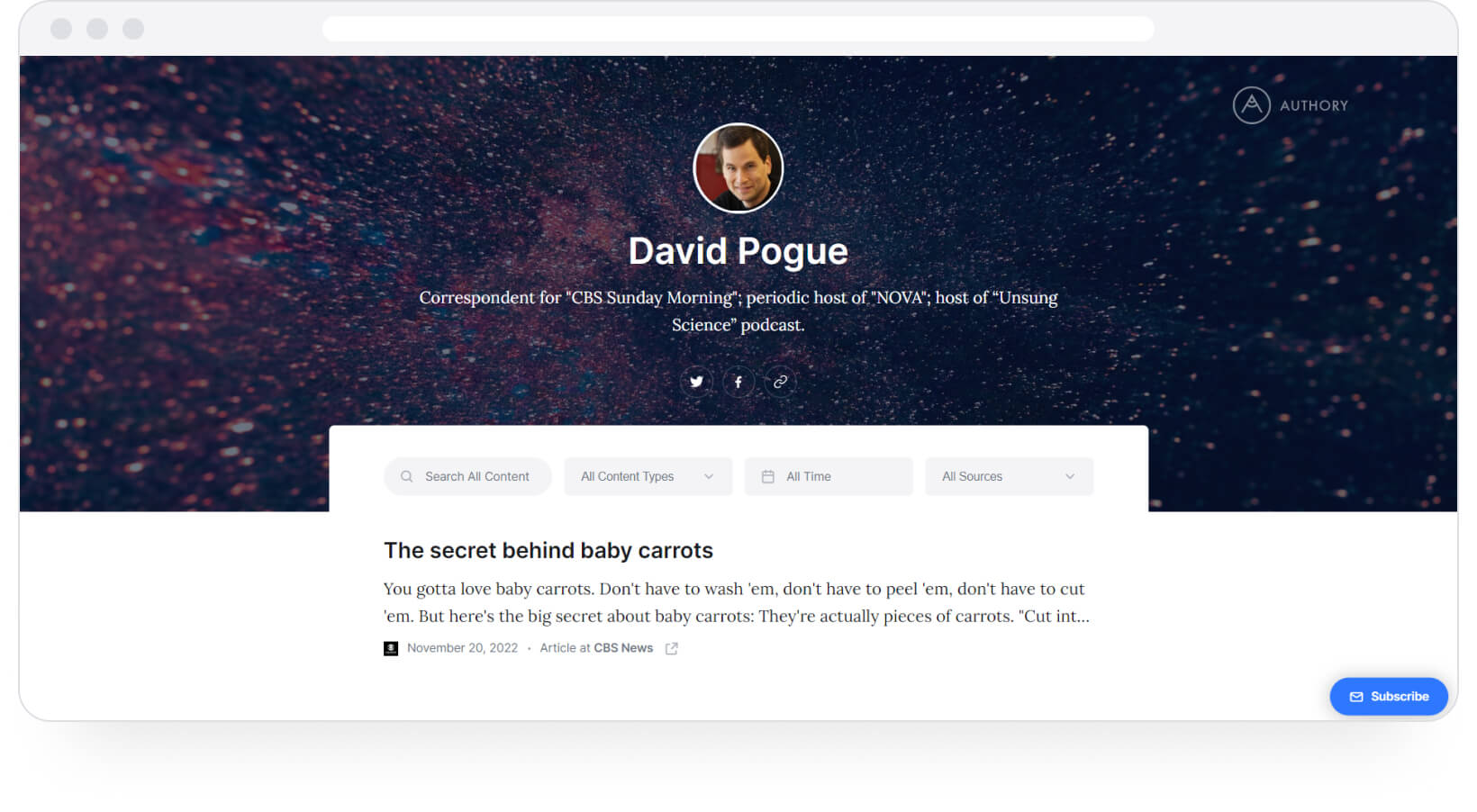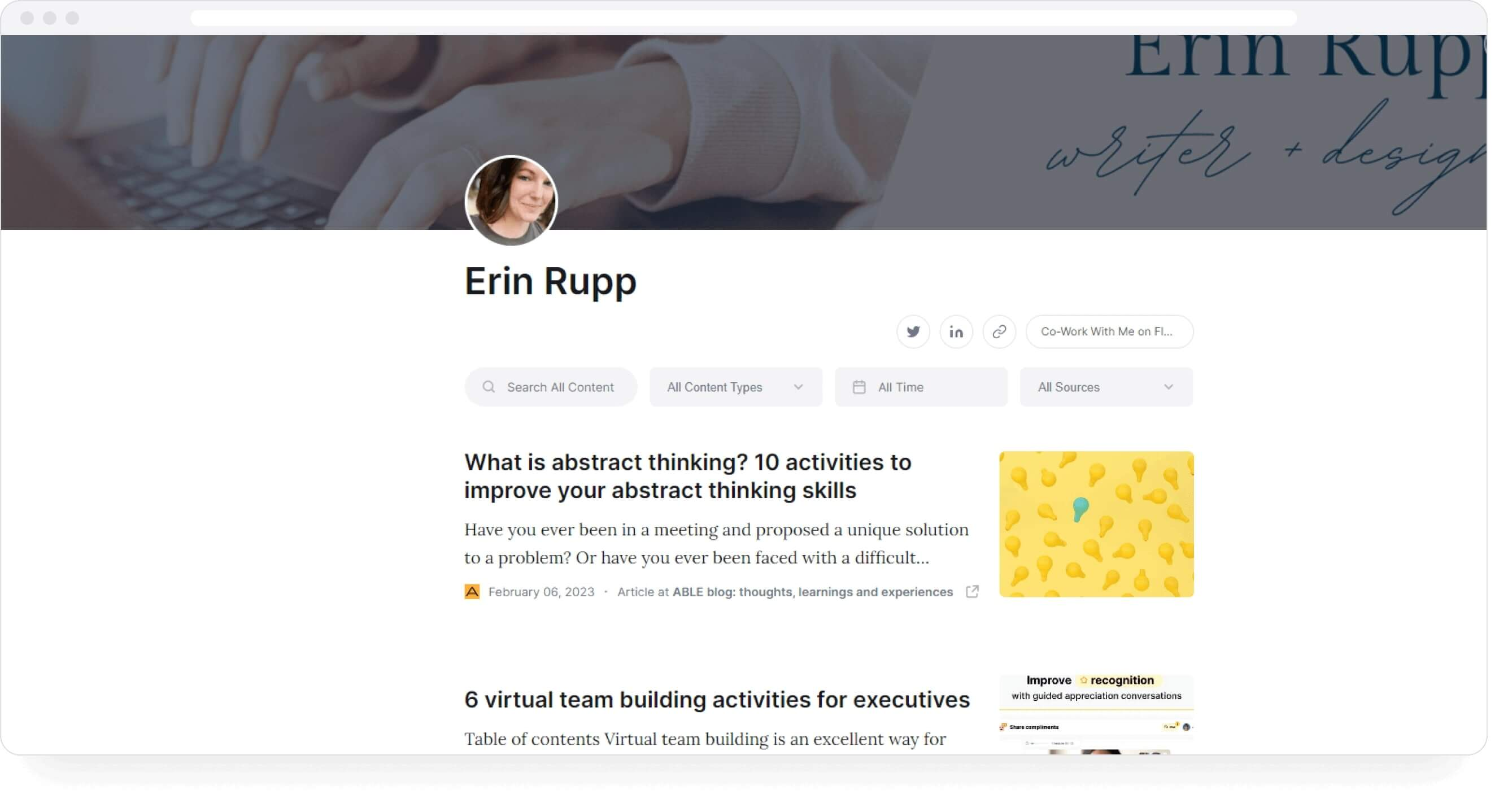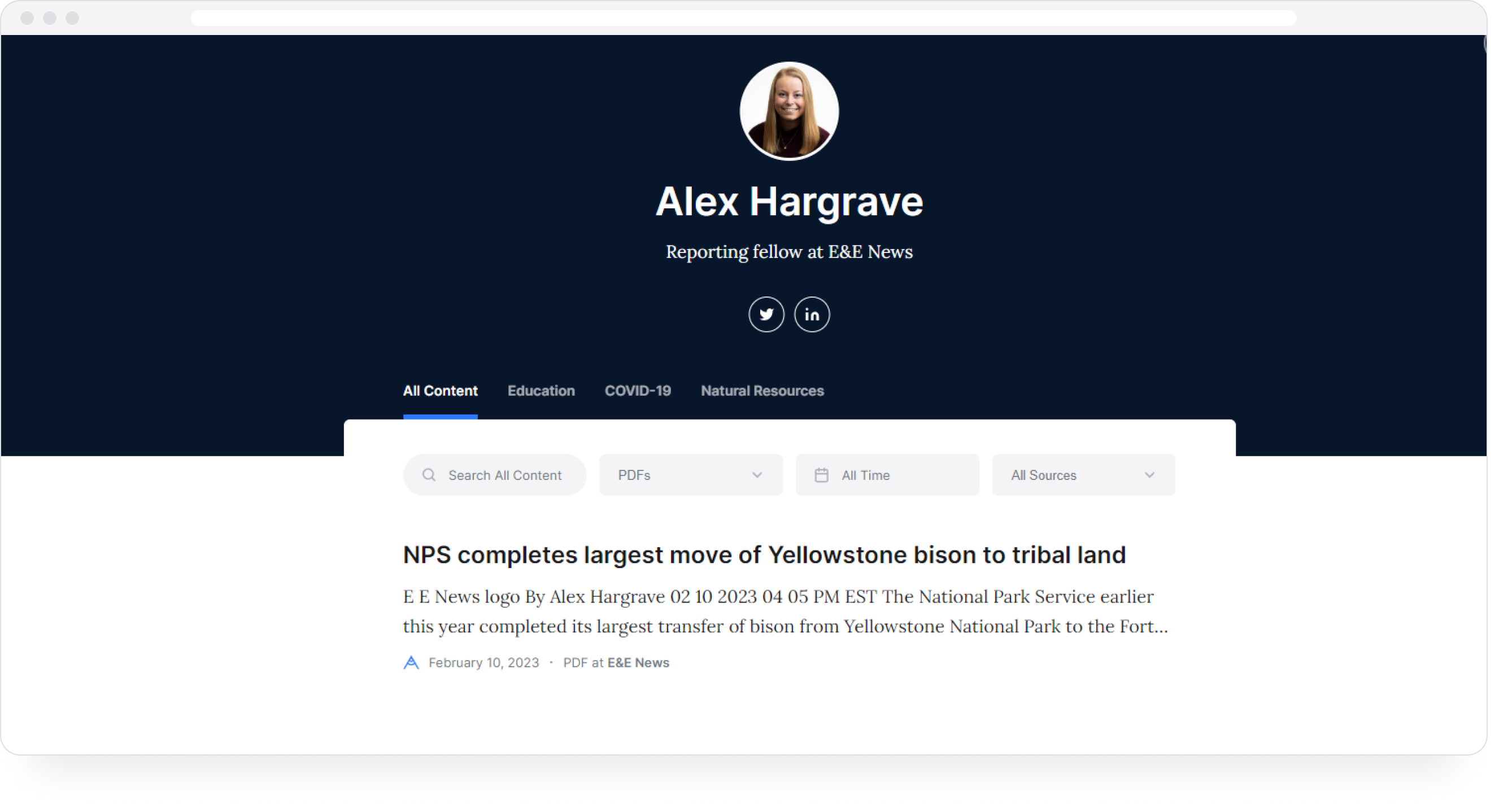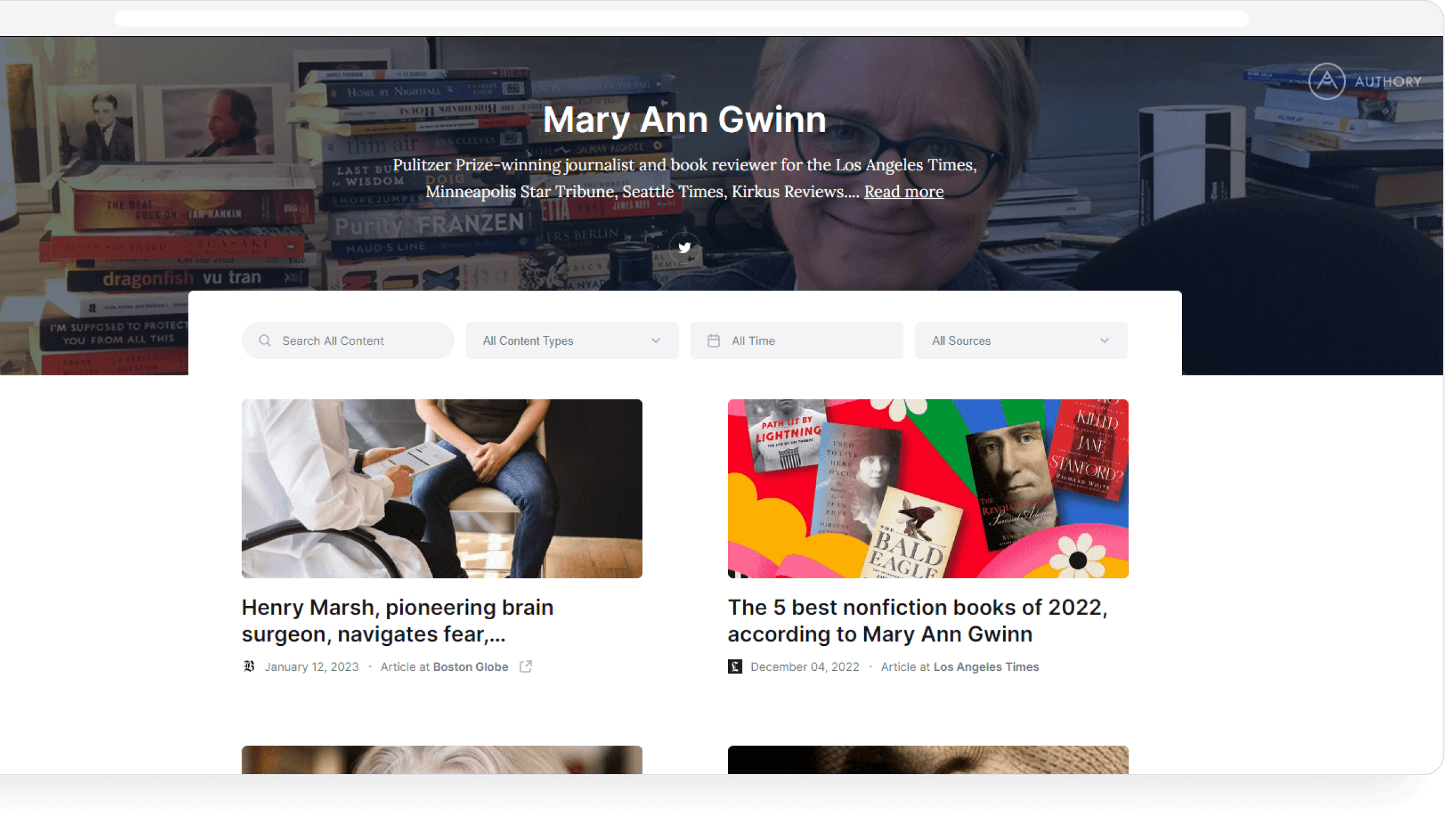Writing for a living? Amazing. I do it too, and it can be pretty rewarding, right?
However, if you're looking for "What is a writing portfolio?" on Google, is it safe to say that you might just be starting out? If so, this is absolutely the right place to start.
In this article, I'll be taking you through the basics of the question: What is a writing portfolio? This will include everything you need to create excellent writing portfolios, including a tool that does most of the work for you.
• Definition & essential features of a great writing portfolio
• How to create a professional writing portfolio with very little effort (using Authory)
• Writing portfolio examples for inspiration
• Why you should use Authory to create your writing portfolio — imports all your work AND saves it automatically forever
So, what is a writing portfolio?
A writing portfolio showcases your best work to potential clients and employers. It is a collection of writing samples that display your writing skills, and make the point that you should be employed and paid for these skills. It’s especially necessary if you're looking for freelance writing jobs.
It also includes information about your academic background, achievements, interests, and contact information. While this sounds simple enough, it's not always easy to put together a portfolio that looks good, is easy to scroll through, and reliably shows your expertise in your writing niche.
Needless to say, the modern portfolio is a portfolio website. No one is physically lugging oversized binders with printed samples to offices. A good writing portfolio is an online writer portfolio.
What should go into your writer's portfolio?
A succinct but comprehensive introduction
Keep things short, unless you're a winner of multiple major awards or you've studied in two different Ivy League schools. Otherwise, briefly mention what you do, who you've worked with, and any outstanding achievements (awards, Guinness Book Record for deep ocean diving, etc.).
If you're a freelance writer who needs a freelance writing portfolio, you can include a line or two from a notable client testimonial.
ALL your work in ALL formats (text, audio, video)
This is the heart of every writing portfolio site. If you're a writer or journalist, showcase your articles. If you're a photographer, display your best photos. If you're a graphic designer, exhibit videos, websites, animated elements, and still images you've worked on.
If you've produced content across different formats (text, audio, video), include all of it in your own portfolio. This is especially true for freelance writers.
It indicates that you're comfortable working with multiple content avenues and makes you an asset for companies looking to expand their presence on numerous social channels.
A portfolio builder like Authory lets your import your work in different formats (text, audio, video, and social media posts).
Potential clients want to see writing portfolio sites showing off that you stay good at your job over time and aren't just a one-hit-wonder. The fact that you've written one great article a year isn't as great as writing one great article each month or week
Your digital portfolio should display this, and the best way to do so is to import ALL (or most) of your work in ALL formats — and display them accordingly on your portfolio.
Read More: Why your portfolio should include ALL your work in ALL formats (audio, video, text)
Real-world results
Nothing speaks like real-world results. Writing portfolios that showcase some real-world results are usually the ones that get more attention.
If you've got a few years of experience, you should have some numbers to indicate your competence. Have you written 50 articles in a year, perhaps? Have these articles driven organic traffic up 34% during that year? As a content marketer, have your skills driven greater engagement with a site or an even higher number of signups or purchases?
Writing portfolio examples to aspire to
David Pogue

David Pogue is a six-time Emmy winner, a New York Times bestselling author, and a five-time TED speaker. He is also a correspondent for "CBS Sunday Morning," a periodic host of "NOVA;" as well as the host of the “Unsung Science” podcast.
Erin Rupp

Erin Rupp writes about productivity, well-being, and self-development. Her work stands out because of her depth of research, as well as insights from her own experiences.
Alex Hargrave

Alex Hargrave is a Reporting fellow at E&E News. Her portfolio page showcases a number of impressive writing samples (some of them in PDF).
Mary Ann Gwinn

Mary Ann Gwinn is a Pulitzer Prize-winning journalist and book reviewer for the Los Angeles Times, Minneapolis Star Tribune, Seattle Times, Kirkus Reviews, and other publications. She is also a Pulitzer jurist.
Why use Authory to create your writing portfolio?
As demonstrated above, Authory doesn’t just give you the space to copy-paste links for writing portfolio sites. It literally does over half the work: finding all bylined content you’ve ever published, importing it automatically, saving it permanently (again, automatically), and enabling you to organize your pieces into different collections.
A self-updating portfolio (no need to keep adding new work manually)
Authory will AUTOMATICALLY import a copy of every bylined piece from every site into its own database.
These sites are called "sources." You add as many sources as you want, and every single bylined piece from every single source will be imported automatically.
You don't have to track down links to your published work (especially older pieces). As long as you remember the URL of the site where your work exists, Authory will collate all your content for you in one dashboard.
Authory can import content from behind most soft paywalls (as long as it is a bylined piece) and some hard paywalls. However, it cannot be used to import copies of articles, podcasts, and videos you haven’t created or featured in.
There isn’t any need to manually upload/copy-paste your content. That said, if you happen to have any non-bylined content, you can always do so manually in those cases.
Automated backups (never lose your content, ever)
All the content that Authory imports from different sources is saved permanently. You'll never have to worry about losing any of your published work. Even if the original website where it's published goes defunct for any reason, you'll always have a copy safely stored on Authory's server.
All backups are in the original format — text and/or media. No screenshots. This is super important because it lets you search through your content database, making it a valuable research tool.
Continued importing of past and future content (less effort for a 100% updated portfolio)
Once you enter a source, Authory won't just import your existing publications. Anything you publish on the same site (after you've fed its URL into Authory) in the future will also be imported automatically. In other words, Authory will import your past and future content.
Authory also sends email notifications for every new piece it imports, so you'll always know if something you submitted has been published.
Apart from these, you also get a slew of miscellaneous but necessary features:
- Ability to search through both your portfolio and your content database to find articles/audio/videos based on keywords. Prospective employers and hiring managers can use this to look for topics on your portfolio, and you can use it to find specific pieces within your Authory content bank.
- Ability to create a custom domain with a click.
- All imported content can be downloaded as high-res PDFs or exportable as HTML files — no lock-in period.
- Get a custom domain and personalize your online writing portfolio even further.
- Multiple, low-effort options for customization to make your portfolio visually appealing and easy to navigate.
- In-built analytics that provides real numbers on content performance (engagement, readership) across the web and popular social media sites every 30 days. You get to see how your readers/viewers are responding to your work.
- Allows creation of newsletters with a couple of clicks. After setup, Authory will automatically send your newly published content to subscribers.
- Widgets to display your personal portfolio on other sites, such as your personal website (if you have one).
As a freelance writer myself, I can vouch for the fact that Authory doesn't just give you an online portfolio. It actively makes your professional life easier for you. It's much easier to get freelance writing jobs
Authory has been chosen by quite a few well-known names in my domain, people who could have picked any tool in the world. There's 6-time Emmy award winner David Pogue, Steven Levy, Editor at Large, WIRED, and Brian Fung, a Technology Reporter at CNN, to name a very few. If they chose Authory to create their online writing portfolios, then I figured I should too.
Get started with Authory for free and see for yourself what works for you!




